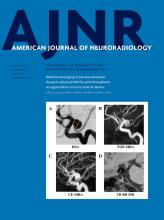Index by author
Schmutzhard, J.
- FELLOWS' JOURNAL CLUBHead & NeckYou have accessReadout-Segmented Echo-Planar DWI for the Detection of Cholesteatomas: Correlation with Surgical ValidationN. Fischer, V.H. Schartinger, D. Dejaco, J. Schmutzhard, H. Riechelmann, M. Plaikner and B. HenningerAmerican Journal of Neuroradiology June 2019, 40 (6) 1055-1059; DOI: https://doi.org/10.3174/ajnr.A6079
Readout-segmented echo-planar (RESOLVE)-DWI is a new alternative technique for obtaining DWI with high quality, delivering sharp images at high spatial resolution and reduced slice thickness. Fifty patients with chronic otitis media who underwent MR imaging before an operation of the middle ear were included. The MR imaging protocol consisted of axial and coronal readout-segmented echo-planar DWI with b-values of 0 and 1000 s/mm2 and 3-mm slice thickness. The readout segmented echo-planar diffusion-weighted images were fused with standard T2-weighted sequences for better anatomic assignment. Readout-segmented echo-planar DWI detected 22 of the 25 cases of surgically proved cholesteatoma. It has an accuracy of 92%, a sensitivity of 88%, a specificity of 96%, a positive predictive value of 96%, and a negativepredictive value of 89%. Readout-segmented echo-planar DWI is a promising and reliable MR imaging sequence for the detection and exclusion of cholesteatoma.
Sgreccia, A.
- FELLOWS' JOURNAL CLUBNeurointerventionYou have accessFirst-Line Sofia Aspiration Thrombectomy Approach within the Endovascular Treatment of Ischemic Stroke Multicentric Registry: Efficacy, Safety, and Predictive Factors of SuccessG. Marnat, X. Barreau, L. Detraz, R. Bourcier, B. Gory, A. Sgreccia, F. Gariel, J. Berge, P. Menegon, M. Kyheng, J. Labreuche, A. Consoli, R. Blanc and B. Lapergue on behalf of the ETIS InvestigatorsAmerican Journal of Neuroradiology June 2019, 40 (6) 1006-1012; DOI: https://doi.org/10.3174/ajnr.A6074
The authors performed a retrospective analysis of the prospectively maintained Endovascular Treatment of Ischemic Stroke multicentric registry. Data from consecutive patients who benefited from thrombectomy with a first-line Sofia approach between January 2013 and April 2018 were studied. We excluded other first-line approaches (stent retriever or combined aspiration and stent retriever) and extracranial occlusions. During the study period, 296 patients were treated. Mean age and initial NIHSS score were, respectively, 69.5 years and 16. Successful reperfusion, defined by the modified TICI 2b/3, was obtained in 86.1%. Complete reperfusion (modified TICI 3) was obtained in 41.2%. A first-pass effect was achieved in 24.2%. A rescue stent retriever approach was required in 29.7%. The first-line contact aspiration approach appeared safe and efficient with Sofia catheters. These devices achieved very high reperfusion rates with a low requirement for stent retriever rescue therapy, especially for M1 occlusions.
Shaibani, A.
- Adult BrainOpen AccessDiagnostic Accuracy of High-Resolution Black-Blood MRI in the Evaluation of Intracranial Large-Vessel Arterial OcclusionsA.S. Al-Smadi, R.N. Abdalla, A.H. Elmokadem, A. Shaibani, M.C. Hurley, M.B. Potts, B.S. Jahromi, T.J. Carroll and S.A. AnsariAmerican Journal of Neuroradiology June 2019, 40 (6) 954-959; DOI: https://doi.org/10.3174/ajnr.A6065
Sharma, A.
- Head & NeckYou have accessEvaluating the Utility of a Postprocessing Algorithm for MRI Evaluation of Optic NeuritisL. Stunkel, A. Sharma, M.S. Parsons, A. Salter and G.P. Van StavernAmerican Journal of Neuroradiology June 2019, 40 (6) 1043-1048; DOI: https://doi.org/10.3174/ajnr.A6057
Shigemoto, Y.
- PediatricsOpen AccessRadiologic and Pathologic Features of the Transmantle Sign in Focal Cortical Dysplasia: The T1 Signal Is Useful for Differentiating SubtypesYukio Kimura, A. Shioya, Y. Saito, Y. Oitani, Y. Shigemoto, E. Morimoto, F. Suzuki, N. Ikegaya, Yuiko Kimura, K. Iijima, Y. Takayama, M. Iwasaki, M. Sasaki and N. SatoAmerican Journal of Neuroradiology June 2019, 40 (6) 1060-1066; DOI: https://doi.org/10.3174/ajnr.A6067
Shioya, A.
- PediatricsOpen AccessRadiologic and Pathologic Features of the Transmantle Sign in Focal Cortical Dysplasia: The T1 Signal Is Useful for Differentiating SubtypesYukio Kimura, A. Shioya, Y. Saito, Y. Oitani, Y. Shigemoto, E. Morimoto, F. Suzuki, N. Ikegaya, Yuiko Kimura, K. Iijima, Y. Takayama, M. Iwasaki, M. Sasaki and N. SatoAmerican Journal of Neuroradiology June 2019, 40 (6) 1060-1066; DOI: https://doi.org/10.3174/ajnr.A6067
Sidhu, P.S.
- Extracranial VascularYou have accessAn Ultrasonographic Multiparametric Carotid Plaque Risk Index Associated with Cerebrovascular Symptomatology: A Study Comparing Color Doppler Imaging and Contrast-Enhanced UltrasonographyV. Rafailidis, I. Chryssogonidis, C. Xerras, E. Grisan, G.-A. Cheimariotis, T. Tegos, D. Rafailidis, P.S. Sidhu and A. Charitanti-KouridouAmerican Journal of Neuroradiology June 2019, 40 (6) 1022-1028; DOI: https://doi.org/10.3174/ajnr.A6056
Singhal, A.B.
- EDITOR'S CHOICEAdult BrainOpen AccessEnsemble of Convolutional Neural Networks Improves Automated Segmentation of Acute Ischemic Lesions Using Multiparametric Diffusion-Weighted MRIS. Winzeck, S.J.T. Mocking, R. Bezerra, M.J.R.J. Bouts, E.C. McIntosh, I. Diwan, P. Garg, A. Chutinet, W.T. Kimberly, W.A. Copen, P.W. Schaefer, H. Ay, A.B. Singhal, K. Kamnitsas, B. Glocker, A.G. Sorensen and O. WuAmerican Journal of Neuroradiology June 2019, 40 (6) 938-945; DOI: https://doi.org/10.3174/ajnr.A6077
Convolutional neural networks were trained on combinations of DWI, ADC, and low b-value-weighted images from 116 subjects. The performances of the networks (measured by the Dice score, sensitivity, and precision) were compared with one another and with ensembles of 5 networks. An ensemble of convolutional neural networks trained on DWI, ADC, and low b-value-weighted images produced the most accurate acute infarct segmentation over individual networks. Automated volumes correlated with manually measured volumes for the independent cohort.
Soni, N.
- Adult BrainOpen AccessTexture Analysis in Cerebral Gliomas: A Review of the LiteratureN. Soni, S. Priya and G. BathlaAmerican Journal of Neuroradiology June 2019, 40 (6) 928-934; DOI: https://doi.org/10.3174/ajnr.A6075
Sorensen, A.G.
- EDITOR'S CHOICEAdult BrainOpen AccessEnsemble of Convolutional Neural Networks Improves Automated Segmentation of Acute Ischemic Lesions Using Multiparametric Diffusion-Weighted MRIS. Winzeck, S.J.T. Mocking, R. Bezerra, M.J.R.J. Bouts, E.C. McIntosh, I. Diwan, P. Garg, A. Chutinet, W.T. Kimberly, W.A. Copen, P.W. Schaefer, H. Ay, A.B. Singhal, K. Kamnitsas, B. Glocker, A.G. Sorensen and O. WuAmerican Journal of Neuroradiology June 2019, 40 (6) 938-945; DOI: https://doi.org/10.3174/ajnr.A6077
Convolutional neural networks were trained on combinations of DWI, ADC, and low b-value-weighted images from 116 subjects. The performances of the networks (measured by the Dice score, sensitivity, and precision) were compared with one another and with ensembles of 5 networks. An ensemble of convolutional neural networks trained on DWI, ADC, and low b-value-weighted images produced the most accurate acute infarct segmentation over individual networks. Automated volumes correlated with manually measured volumes for the independent cohort.








